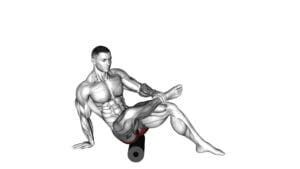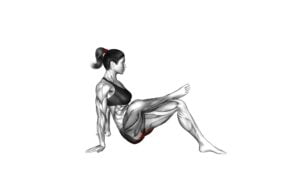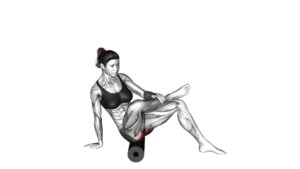Arm-up Rotator Stretch – Video Exercise Guide & Tips

Are you looking for a quick and effective way to stretch your rotator cuff muscles? Look no further than the Arm-up Rotator Stretch!
Watch This Exercise Video
In this video exercise guide, you'll learn the proper form and technique to get the most out of this stretch. We'll also cover common mistakes to avoid, variations and modifications, and how to incorporate this stretch into your routine.
Get ready to improve your flexibility and prevent shoulder injuries with this informative guide.
Key Takeaways
- The Arm-up Rotator Stretch improves shoulder mobility and flexibility.
- It targets the rotator cuff muscles and enhances shoulder mobility.
- Performing this stretch reduces the risk of injury and increases range of motion in the shoulders.
- Incorporating the Arm-up Rotator Stretch into your routine promotes relaxation and alleviates muscle tension.
Benefits of the Arm-up Rotator Stretch
The arm-up rotator stretch offers numerous benefits for improving shoulder mobility and flexibility. This exercise specifically targets the rotator cuff muscles, which are responsible for stabilizing and rotating the shoulder joint. By incorporating arm-up exercises into your routine, you can enhance your shoulder mobility and reduce the risk of injury.
One of the key benefits of the arm-up rotator stretch is that it helps to increase the range of motion in your shoulders. By performing this stretch regularly, you can improve the flexibility of the muscles and tendons surrounding the shoulder joint, allowing for greater freedom of movement.
Another advantage of the arm-up rotator stretch is its ability to strengthen the rotator cuff muscles. As you perform this exercise, you're actively engaging these muscles, which helps to build strength and stability in the shoulder joint. This can be particularly beneficial for athletes who engage in sports that require overhead movements, such as swimming or tennis.
Proper form and technique are crucial when performing the arm-up rotator stretch to ensure maximum benefit and minimize the risk of injury. It's important to maintain good posture throughout the exercise, keeping your shoulders relaxed and your spine straight. Additionally, be sure to use controlled movements and avoid any jerking or bouncing motions.
Proper Form and Technique
To perform the Arm-up Rotator Stretch correctly, it's crucial to avoid common mistakes and focus on proper technique. This ensures maximum effectiveness and minimizes the risk of injury.
Avoiding Common Mistakes
Maintain proper form and technique to avoid common mistakes during the Arm-up Rotator Stretch exercise. This will help you prevent injuries and get the most out of your warm-up routine.
Here are some key tips to keep in mind:
- Alignment: Make sure your body is properly aligned throughout the stretch. Keep your spine straight and your shoulders relaxed.
- Gentle Stretch: Avoid pulling or jerking movements that can strain your muscles. Instead, focus on a gentle and controlled stretch.
- Breathing: Remember to breathe deeply and evenly while performing the stretch. This will help you relax and improve the effectiveness of the exercise.
Importance of Proper Technique
To maximize the benefits of the Arm-up Rotator Stretch, it's crucial for you to focus on maintaining proper form and technique throughout the exercise. Proper technique ensures that you engage the targeted muscles effectively, while minimizing the risk of injury.
Before performing the Arm-up Rotator Stretch, it's important to warm up your shoulders with dynamic movements such as arm circles or shoulder rolls. This helps increase blood flow to the muscles, making them more pliable and reducing the chances of strains or tears.
Additionally, proper form involves keeping your spine straight, shoulders relaxed, and avoiding any sudden or jerky movements. By following these guidelines and incorporating warm-up exercises, you can effectively prevent shoulder injuries and maximize the benefits of the Arm-up Rotator Stretch.
Common Mistakes to Avoid
To ensure maximum effectiveness and safety during the arm-up rotator stretch, it's important to maintain proper form. This not only helps to prevent injuries but also ensures that you're targeting the correct muscles.
Proper Form Importance
Ensure Proper Form for Maximum Benefit and Injury Prevention
When performing arm up exercises and stretching techniques, it's crucial to maintain proper form. This not only maximizes the benefits of the exercise but also helps prevent injuries.
Here are some common mistakes to avoid:
- Rounded Shoulders: Keep your shoulders back and down throughout the movement to avoid rounding them forward, which can strain the muscles and joints.
- Overarching Back: Maintain a neutral spine position and avoid excessive arching of the back, as this can lead to lower back pain.
- Jerky Movements: Perform the exercise in a controlled and smooth manner, avoiding sudden or jerky movements that can strain the muscles or cause joint instability.
Injury Prevention Techniques
Avoid these common mistakes to prevent injuries during warm-up exercises and stretching techniques.
Proper form and technique are crucial for injury prevention and maximizing the benefits of stretching exercises.
One common mistake to avoid is rushing through the warm-up phase. Make sure to allocate enough time for a proper warm-up, which includes dynamic stretching exercises.
Another mistake is neglecting to stretch all major muscle groups. It's important to stretch the arms, legs, back, and core to maintain overall flexibility and prevent muscle imbalances.
Additionally, avoid bouncing or jerking movements during stretches, as this can lead to muscle strains or tears.
Lastly, don't push yourself beyond your limits. Listen to your body and gradually increase the intensity and duration of your stretches over time.
Correcting Common Misconceptions
Correct common misconceptions and avoid making mistakes by focusing on proper form and technique during warm-up exercises and stretching techniques. Injury prevention and flexibility training are essential components of any exercise routine. Here are some common misconceptions to avoid:
- Avoiding warm-up exercises: Some people believe that warm-up exercises are unnecessary or a waste of time. However, warming up helps increase blood flow to the muscles, prepares them for activity, and reduces the risk of injury.
- Bouncing during stretches: Many people make the mistake of bouncing or jerking during stretches. This can lead to muscle strains or tears. Instead, focus on slow, controlled movements to stretch the muscles safely.
- Neglecting symmetry: It's crucial to give equal attention to both sides of the body during stretching and flexibility training. Neglecting one side can lead to muscle imbalances and increased risk of injury.
Variations and Modifications
To modify the arm-up rotator stretch, try using a resistance band for added intensity. This variation can help you increase the difficulty of the exercise and target your rotator cuff muscles more effectively.
Start by attaching one end of the resistance band to a secure anchor point, such as a doorknob. Hold the other end of the band with your hand, keeping your elbow bent at a 90-degree angle.
Stand with your feet shoulder-width apart and rotate your forearm away from your body, extending your arm as far as you comfortably can. Hold the stretch for a few seconds before slowly returning to the starting position. Repeat the movement for the desired number of repetitions.
Remember to maintain proper form and control throughout the exercise.
This modification is ideal for individuals who've mastered the basic arm-up rotator stretch and are looking for a more challenging variation to further strengthen their rotator cuff muscles.
Incorporating the Stretch Into Your Routine
To incorporate the arm-up rotator stretch into your routine, you can follow these simple steps:
- Start by standing with your feet shoulder-width apart and your arms relaxed at your sides.
- Slowly raise one arm straight out in front of you, keeping it parallel to the ground.
- Bend your raised arm at the elbow and bring it across your body towards the opposite shoulder.
- Use your other hand to gently pull the raised arm closer to your body, feeling a stretch in the back of your shoulder.
- Hold the stretch for 15-30 seconds, breathing deeply and maintaining good posture.
- Repeat the stretch on the other arm.
Incorporating stretching into your workout routine offers numerous benefits. Stretching helps improve flexibility, which can enhance performance in activities that require a wide range of motion. Regular stretching can also reduce the risk of injury by increasing the elasticity of muscles and tendons.
Additionally, stretching can alleviate muscle tension and promote relaxation, making it a great way to unwind after a workout. By incorporating the arm-up rotator stretch into your routine, you can specifically target the muscles in your shoulders and upper back, helping to improve posture and prevent shoulder pain.
Safety Precautions and Tips
Remember to always perform the arm-up rotator stretch with caution and regularly to reap its benefits. Safety precautions and tips are crucial to prevent injuries and optimize the effectiveness of your warm-up exercises.
Firstly, it's important to warm up your body before performing the arm-up rotator stretch. This can be done through light aerobic exercises such as jogging or jumping jacks to increase blood flow and prepare your muscles for stretching. Additionally, dynamic stretching exercises for the shoulders and arms, such as arm circles or shoulder rolls, can help to further warm up the rotator cuff muscles.
When performing the arm-up rotator stretch, it's essential to maintain proper form and technique. Keep your back straight and your core engaged throughout the exercise. Avoid jerking or bouncing movements, as this can strain the muscles and increase the risk of injury. Instead, perform slow and controlled movements to stretch the rotator cuff muscles effectively.
Furthermore, listen to your body and avoid pushing beyond your limits. If you experience any pain or discomfort during the stretch, stop immediately and consult a healthcare professional if necessary. It's better to start with a lighter stretch and gradually increase the intensity as your flexibility improves.
Frequently Asked Questions
How Many Times a Week Should I Perform the Arm-Up Rotator Stretch?
To get the most out of the arm-up rotator stretch, it's recommended to perform it 2-3 times a week. This stretch targets the rotator cuff muscles, increasing their flexibility and reducing the risk of injury.
To properly perform the arm-up rotator stretch, start by standing upright and extending one arm straight out in front of you. Then, use your other hand to gently pull your extended arm across your body until you feel a stretch in your shoulder.
Hold for 20-30 seconds and repeat on the other side.
Can the Arm-Up Rotator Stretch Help Improve Shoulder Flexibility?
The arm-up rotator stretch has several benefits for improving shoulder flexibility and mobility. This exercise specifically targets the rotator cuff muscles, which play a crucial role in shoulder movement. By performing this stretch regularly, you can increase the range of motion in your shoulder joint and reduce the risk of pain or injury.
Incorporating shoulder stretching exercises into your routine can have a positive impact on your overall shoulder health and help you maintain proper posture and form during various activities.
Is the Arm-Up Rotator Stretch Suitable for Individuals With Shoulder Injuries?
The arm-up rotator stretch can be modified to suit individuals with shoulder injuries. Modifying the stretch can help accommodate limitations and prevent further injury.
It's important to consult with a healthcare professional or physical therapist to determine the appropriate modifications for your specific injury.
The arm-up rotator stretch has several benefits for rehabilitation, including improving shoulder flexibility and range of motion, strengthening the rotator cuff muscles, and promoting healing and recovery.
Are There Any Alternative Stretches That Target the Same Muscle Groups as the Arm-Up Rotator Stretch?
If you're looking for alternative stretches that target the same muscle groups as the arm-up rotator stretch, there are a couple of options you can consider.
One is the shoulder external rotation stretch, which focuses on the rotator cuff muscles.
Another option is the sleeper stretch, which specifically targets the subscapularis muscle.
Both of these stretches can help improve flexibility and mobility in the shoulder joint.
It's always important to consult with a healthcare professional before starting any new stretching routine, especially if you have a shoulder injury.
Can the Arm-Up Rotator Stretch Be Beneficial for Athletes in Sports Such as Swimming or Tennis?
The arm-up rotator stretch can provide significant benefits for athletes in sports like swimming or tennis. It helps to improve shoulder mobility and flexibility, which are crucial for generating power and preventing injuries in these sports.
To perform the stretch effectively, start by standing with your arm extended and parallel to the ground. Then, rotate your arm upward and across your body, feeling a stretch in your shoulder.
Hold for 20-30 seconds and repeat on the other side.
Conclusion
Incorporating the arm-up rotator stretch into your exercise routine can provide numerous benefits, including improved flexibility and range of motion in the shoulders and upper back.
By following proper form and technique, you can maximize the effectiveness of this stretch.
Be sure to avoid common mistakes and consider variations or modifications to suit your individual needs.
Remember to prioritize safety and consult with a healthcare professional before starting any new exercise program.

Author
Years ago, the spark of my life’s passion ignited in my mind the moment I stepped into the local gym for the first time. The inaugural bead of perspiration, the initial endeavor, the very first surge of endorphins, and a sense of pride that washed over me post-workout marked the beginning of my deep-seated interest in strength sports, fitness, and sports nutrition. This very curiosity blossomed rapidly into a profound fascination, propelling me to earn a Master’s degree in Physical Education from the Academy of Physical Education in Krakow, followed by a Sports Manager diploma from the Jagiellonian University. My journey of growth led me to gain more specialized qualifications, such as being a certified personal trainer with a focus on sports dietetics, a lifeguard, and an instructor for wellness and corrective gymnastics. Theoretical knowledge paired seamlessly with practical experience, reinforcing my belief that the transformation of individuals under my guidance was also a reflection of my personal growth. This belief holds true even today. Each day, I strive to push the boundaries and explore new realms. These realms gently elevate me to greater heights. The unique combination of passion for my field and the continuous quest for growth fuels my drive to break new ground.







